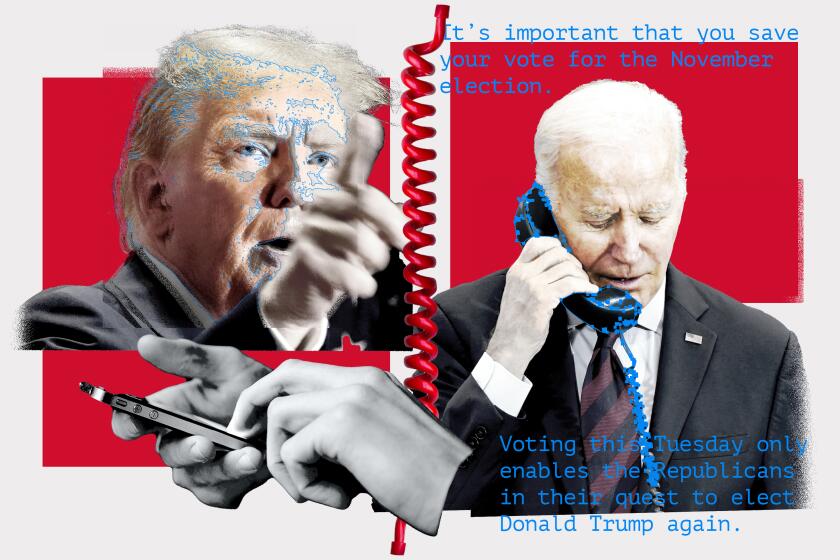Road to Recovery Heads Steeply Uphill for SFE Technologies : Electronics: The San Fernando maker of capacitors is strapped for cash and coming off five straight years in the red. But its new leader is optimistic.
In October the board of SFE Technologies hired William P. Kuehn as its new chief executive because, as Kuehn puts it, he’s a “crisis manager.”
He had better be. Since 1985, when SFE’s biggest customer took most of its business elsewhere, the San Fernando electronics company has foundered, struggling to find a profitable market for its electronic components called capacitors, which are used widely in electronic devices to control the flow of electricity into semiconductor chips. One big problem has been stiff foreign competition, notably from the Japanese.
As a result, Kuehn inherited a company that has piled up five straight years of losses totaling $40.5 million. And the company currently operates on a razor-thin cash reserve of only $230,000, or less than the annual payments on just one of its long-term borrowings.
Worse, SFE has been struggling to stay on good terms with its lenders. In the past two years the company missed payments on some of its bank loans and violated loan agreements on other borrowings. Also, SFE faces lawsuits that could cost it as much as $4 million in damages. The problems are so bad, SFE’s accountants recently warned that if SFE has to pay large damages in its lawsuits or can’t placate its banks, the company could go under.
Investors don’t like the picture either. SFE stock has fallen from a high of about $23 a share in 1983 to about 25 cents, making it literally a two-bit stock.
But Kuehn, a deliberate man who referred to 3-by-5-inch cards in his lap while outlining SFE’s strategy during an interview, says he expects the company to be back on its feet by June and making a profit by the end of the year.
He says the banks have agreed to revised payment plans and that SFE’s costs of operations already have been cut as much as they can. The company’s work force has been nearly halved since 1985, due in a large part to the selling off of five subsidiaries. He’s also confident about resolving the lawsuits, and he’s written off $7 million in excess inventory and hopes to sell it for whatever he can get later this year to raise some cash.
After all that, he says, SFE will be able to take advantage of its “strong position” in the market for its basic product--multilayer ceramic capacitors--and a line of customized electronic parts.
But others have heard this tune before.
“Those are the right steps to do. But they’ve always been doing something like that over the years,” said John Reddan, an analyst for Moran Asset Management Co. in Greenwich, Conn., a money management firm that bought about a 15% stake in SFE in 1986, thinking that the stock was a bargain at about $8 per share.
Kuehn counters that there’s nothing he can do about investors’ skepticism. “They’re going to just have to wait. You don’t turn around a company overnight unless you’re fabulously lucky.”
SFE’s board of directors picked Kuehn to replace former chief executive Alan D. Rubendall--who together with his father, SFE founder Donald E. Rubendall, still has a 17% stake in the company--because of Kuehn’s experience in turning around distressed companies, according to board member Richard H. Green Ph.D., technical director of the Jet Propulsion Laboratory at Caltech.
Kuehn, 45, said his resume shows he’s helped about 15 ailing companies deal with financial problems since he became a “crisis manager” in 1982. He said he hasn’t decided whether he will stay on at SFE, if and when the company turns around.
One example from Kuehn’s resume is Carlsbad-based Linear Corp., which lost about $2 million on sales of about $50 million and was violating its loan agreements in 1985, according to Kuehn. Kuehn said he helped the company reorganize while it developed a new product. Linear paid off all its bank debt and was profitable within a year, Kuehn said.
Whether Kuehn can help SFE deal with five years of accumulated problems is another matter.
In the early 1980s, salad days for electronics industry, SFE confidently started new divisions in West Germany, New Orleans, Arizona and North Carolina. But expanding production with borrowed money turned out to be a bad move because the company was selling 40% of its goods to a single customer, AT&T.; In 1985, at the same time that electronics hit a recession, AT&T; was broken up in the culmination of an antitrust suit, and many of the resulting “Baby Bell” companies bought their capacitors from other companies, usually for less than SFE charged.
After the loss of much of AT&T;’s business, SFE’s losses mounted from $5 million in 1985 to $15 million in 1986.
Under hesitant leadership, the company spent three years shedding its least productive divisions. “The management in place just couldn’t handle it,” said David Sonksen, vice president of finance for Microsemi Corp. in Santa Ana, which bought about a 7% stake in SFE in 1988 on the theory the stock was undervalued at about 74 cents per share.
In May, 1988, SFE promoted a vice president, Michael Rosenberg, to president and chief operating officer. Under Rosenberg, SFE quickly sold off a division that had lost a total of $3.4 million in the previous three fiscal years. Kuehn said Rosenberg made a host of other changes that improved SFE’s productivity, cut inventories and reduced costs. Despite Rosenberg’s efforts, SFE began defaulting on loans in 1988, and some of the banks that loaned SFE money lowered the boom.
In 1989, the banks began hinting they wanted SFE chairman Rubendall to step down, said SFE director Green. Then SFE’s board chose Kuehn as Rubendall’s successor.
Kuehn said Rosenthal’s moves had set the stage for a recovery. And Microsemi’s Sonksen also praised Rosenthal, who has stayed on at SFE as chief operating officer.
Kuehn said his most important decisions at SFE have been to write off $7 million in excess inventory and to agree to a settlement in the U.S. Department of Justice’s investigation of an SFE subsidiary in Arizona, West-Cap.
Under the agreement, West-Cap admitted it didn’t properly inspect some of the capacitors it makes for military agencies. West-Cap could face fines totaling anywhere between $20,000 and $1 million and could be barred from selling to the military. But Kuehn said SFE’s lawyers consider a ban unlikely and he hopes the company can persuade the government to be lenient with fines, too.
Kuehn’s next worry is a lawsuit SFE faces in federal district court in Connecticut in which a buyer of SFE components claimed those parts didn’t meet specifications. The buyer is asking $3 million in damages, but SFE predicts it will win the suit.
Even if it does, SFE faces stiff competition. Its biggest U.S. competitor, AVX Corp. in New York, late last year merged with one of its biggest foreign competitors, Kyocera Corp. of Kyoto, Japan. With all that on Kuehn’s hands, just breaking even will be tough for SFE. But Kuehn said, “We expect to show a profit by the end of the year.”
As for investors who have already absorbed the shock of SFE’s relentlessly falling stock, Kuehn admits there are limits to what he and SFE can do. “My focus today is cash flow and turning this company around,” he said. “I don’t really spend any time looking at our stock price, because I can’t do anything about that.”
SFE TECHNOLOGIES AT A GLANCE
SFE Technologies, an electronics company based in San Fernando, has been troubled by losses since a major customer drastically cut back on its orders. The company employs about 1,000 workers in the U.S. and abroad, down from 1,950 in 1985.



